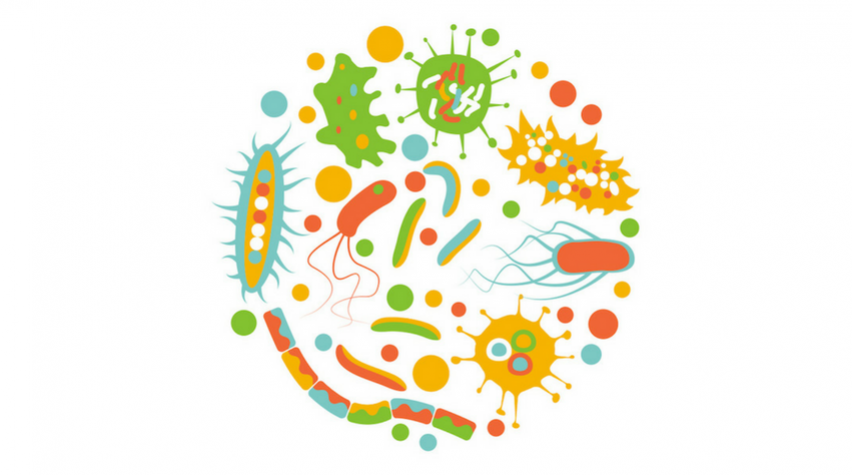
Humans have roughly 40 trillion bacterial cells in their bodies; up to 1,000 species of bacteria live in the human gut alone. With bodies roughly made of 30 trillion human cells, you could say we are perhaps more bacteria than human.
The human microbiome is the collection of organisms, mainly bacteria, that live inside of us — predominantly in the intestines, but also on the skin, in the mouth, etc. Weighing in collectively at 2–5 lb, these microbes work together and function like a whole organ that affects our immune system, heart, weight, brain health, and blood sugar level. An imbalance in the microbiome of the intestines may contribute to weight gain, high blood sugar, high cholesterol, and other disorders.
Microbiomes consist of diverse microbial communities and exist in all types of ecosystems. Any variance in a microbiome can disturb the overall ecosystem and cause diseases and disorders. Microbiome engineering attempts to prevent disturbances by modifying the structures of the microbiota to restore ecological balance, and it has been instrumental in improving human health and agricultural productivity.
Microbiome engineering could redefine healthcare
Imagine if engineered bacteria that have the ability to sense and combat diseases could colonize the human gut. Advances in microbiome engineering and synthetic biology, which have helped to create and rewire biological organisms to perform specified tasks, could enable such a possibility. While synthetic biology has primarily been focused on biofuel production, it has the potential to drastically change the way we approach human health.
The survival of gut microbes depends on their ability to sense their environment for food, pathogens, the inflammatory state of the gut, etc. Researchers have been working with bacterial species that contain genetic circuits, each wired to respond to a different stimulus in the gut.
These circuits can be rewired to elicit a designed response to specific stimuli once triggered. They can be designed to provide site-specific drug delivery within the intestines to target inflammation as it occurs and shut off automatically once the inflammation is eliminated. They have the potential to combat invading pathogens, diagnose early stages of cancer, correct diarrhea or constipation, and regulate mood and behavior.
The intestinal microbiota has been shown to critically influence a multitude of host physiological functions, often through modulation of the immune system. Many antibiotics destroy intestinal microbial communities, increasing susceptibility to intestinal pathogens. To combat this, scientists are designing antimicrobials that target only specific pathogens and deleterious bacteria — a difficult task due to the dynamic nature of the microbiome.
An evolving world inside us
Our microbiomes are constantly changing throughout our lives. As infants, rich communities of microorganisms assemble and develop and change as we mature as a result of diet, hormonal cycles, sexual activity, travel, illnesses, medical treatment, and other factors.
Researchers have studied and analyzed the behavior of the microbiota over time, looking at microbiome dynamics and core fundamental questions. By generating models and developing computational tools to analyze the microbiome, scientists can advance their research with deeper insights into functional changes that occur in the microbiome over time.
One such algorithmic model that scientists are exploring predicts temporal behaviors that are crucial for the design of bacteriotherapies. Through modeling, scientists are now able to accurately forecast microbial dynamics, predict stable subcommunities that inhibit pathogen growth, and identify bacteria critical for community integrity in response to perturbations.
Engineers and scientists in collaboration
Advanced methods for predicting the dynamic behavior of the microbiota have enabled therapeutic manipulation of the microbiota for treatment of infectious, autoimmune, and other diseases. These new modeling and engineering techniques help to overcome the challenges presented by the dynamic nature of the microbiome, which can be perturbed by dietary changes, infections, and antibiotics — even to the point of collapse of whole communities.
New techniques for the study of the microbiota have sparked collaboration between engineers and scientists. This symbiotic relationship has advanced the field to new frontiers and forged discussions such as those taking place at the International Conference on Microbiome Engineering (ICME 2018), Nov. 4–6, 2018, Boston, MA. This conference brings together leaders and experts from the cutting-edge field of microbiome engineering to discuss progress and needs to inform research, technology, and innovation. ICME 2018 explores the importance and applications of microbiome engineering, bringing together experts in industry and academia to discuss the challenges faced by microbiome engineering and the future of the field.
This article originally appeared in the Technical Entity Trends column in the August 2018 issue of CEP. Members have access online to complete issues, including a vast, searchable archive of back-issues found at aiche.org/cep.


